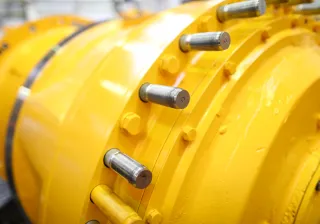Extending the lifecycle and improving the safety of existing operating nuclear power plants provides huge cost savings. ACES is a new European Commission supported H2020-Euratom-1 project (EUR 5.45 million for four years), which will advance the assessment of safety performance of safety-critical concrete infrastructure by addressing remaining scientific and technology gaps for the safe and long-term operation of nuclear power plants. This collaborative project aims to clarify, enhance and unify methods of structural integrity assessment in support of long-term operation.
ACES aims at having a significant impact on the safety of operational Gen II and III nuclear power plants (NPP), and impact the design of next-generation plants. ACES will improve the understanding of ageing and deterioration of concrete, and will demonstrate and quantify inherent safety margins introduced by the conservative approaches used during design and defined by codes and standards employed through-out the life of the plant. The outcomes from ACES will therefore support the long-term operation (LTO) of NPP. This will be achieved by using more advanced and realistic scientific methods to assess the integrity of NPP concrete infrastructure. ACES will provide evidence to support the methods by carrying out various tests, including large scale tests based on replicated scenarios of NPP.
“The ACES project will have a significant impact on the safety of current operational nuclear power plants, and will also impact the design of next-generation plants. It will improve the understanding of ageing of concrete, and more importantly will demonstrate and quantify inherent safety margins defined by codes and standards employed through-out the life of the plant”, says Miguel Ferreira, Project Coordinator at VTT.
The main objective and mission of ACES is to advance the assessment of safety performance of civil engineering structures by addressing remaining scientific and technology gaps for the safe and long-term operation of nuclear power plants safety-critical concrete infrastructure. ACES enables operators and regulators to improve the understanding, and hence the prediction of ageing phenomena occurring in safety-critical concrete infrastructure in order to ensure safe LTO of existing European NPP. This aim will be reached by providing further knowledge and tools to manage the ageing of NPP.
This is achieved by development and validation of:
- Critical review of ageing management practice across EU NPP focusing on deterioration and ageing mechanisms of reinforced concrete, linked to decision-based assessment criteria.
- Improved understanding of corrosion phenomena focusing on embedded liners, predicting the occurrence of corrosion and developing an innovative inspection tool for early detection of corrosion.
- Improved understanding of internal swelling reactions and temperature/moisture effects on the delayed strains of containment buildings; Improved prediction of the evolution of moisture, strain and stress of prestressed concrete containment buildings, during operational and accidental phases.
- Improved assessment of the effects of prolonged irradiation of the concrete biological shield using a holistic approach combining operating conditions, materials degradation and structural significance.
- Improved engineering methods to assess components under long-term operation taking into account specific operational demands.
- Integrated probabilistic assessment methods to account for uncertainties and improve inspection capabilities.
- Innovative quantitative methodologies to transfer laboratory material properties to assess the structural integrity of large concrete components.
- Advanced simulation tools based on nonlinear finite element method, lattice-based models, FFT-based simulation, and combined empirical and mathematical material models reflecting the latest finding related to combined effect of various loading (e.g. environment, radiation, internal swelling reactions) on concrete performance, i.e., the creation and evolution of deterioration areas in concrete structures.
An important goal of ACES is the dissemination and the education of the nuclear engineering and research community. This will improve and harmonise knowledge about NPPs ageing and thereby ensure a high impact of project results. ACES results will be disseminated to main European and international stakeholder.
The project is coordinated by VTT Technical Research Centre of Finland and the consortium consist of 10 European companies and research partners, and one international partner.
Consortium partners:
CEA (France), CTU (Czech Rep.), CVR (Czech Rep.), EDF (France), ENERGORISK (Ukraine), ENGIE LAB (Belgium), IRSN (France), SCK•CEN (Belgium), ZAG (Slovenia), and ORNL (United States).
For more information, please visit:
https://cordis.europa.eu/project/rcn/229803







